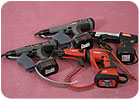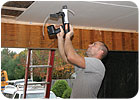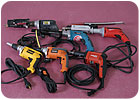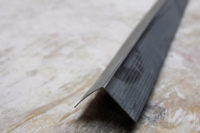
I called up a drywall contractor I know and he said that he only uses DeWalt regular guns. He said battery powered collated (self-feeding) screw guns don’t last, are too heavy, get jammed up often, and are too slow. He also said he had never used one.
I have been using a cordless collated Senco Dura-Spin for years, so I may be a little biased toward that type of tool. I like not being connected to an extension cord and not having to reach into my tool bag for screws and putting each screw on the end of the screwgun. The truth is that these self-feeding screw guns work, and I believe that they can hold up to day-in and day-out use. They are here to stay and will just keep getting a larger and larger share of the market.
I started out as a laborer for my grandfather’s construction company in the late ‘70s and we nailed everything by hand. I would nail plywood for days on end, and I did it pretty quickly. I would hold a bunch of nails in my left hand and as I was driving one with my right, I would get the next nail ready. Then a quick tap and two hits; I would have the #8 common set. When we framed walls I would put the next stud in place, and my uncle would drive a #16 common with 2 hits and set the next one before I could even position the next stud. We were fast and efficient and at first we fought the “new-fangled” nail guns. That company is run by my cousins now and they don’t do any hand nailing anymore.

Time is money
I know that even a few years ago I would not use a drywall lift because I thought it was slower. We worked pretty hard, especially when hanging 9- or 10-foot-high ceilings, but time is money and the heck with our backs and the tops of our heads. I just hung a garage this week and used a hydraulic lift because it is easier, now that I have been using it for a while.My closest competitor in the drywall business, here in upstate New York, still hand-tapes everything. I have seen his crews work and they are fast and smooth, but there is no way they can tape faster than I can. I use the automatic taping tools. Sure there is more up-front cost involved and yes, they do jam up sometimes and need oiling and new parts, but I could not imagine working without them.
The latest and greatest tools and materials may not be any better than what you have been using if you don’t know how to use them to get maximum results. There are efficient ways to work and inefficient ways to work.
If I am hand-taping a room and tape one seam at a time: I apply the compound-put my tools down-position the paper tape-pick up the tools-embed the tape-then start the next seam. I will be working hard and I will be very busy, but it will take much longer to tape a room with this method. If I apply the compound to a lot of seams at once and then apply and embed the tape I will get the room taped a lot faster and will not be working as hard.
I can use a collated screwgun and not be any faster if I don’t properly maintain the tools, if I don’t have a supply of screws in my pouch, if I work the tool too fast and cause jams and misfires, or if I don’t use the tool in the proper way.
It takes about 46 screws to attach a 12-foot piece of drywall to a wall, and 54 to put it on a ceiling. The amount of drywall that a crew can hang in a day varies because of the crew’s ability, the number of hangers in the crew and the type of job. Typically, we hang 4,000 to 5,000 square feet a day, which requires about 4,700 screws. That comes out to about 1,000 screws for 1,000 square feet of drywall. If you hang drywall five to six days a week for 40-something weeks a year, that’s a lot of time and effort spent attaching drywall. When I think about it this way, I see how important having the best tools and fasteners for the job really is.

Many opinions on power tools
When Walls & Ceilings approached me about writing this article I wanted to get a variety of screwguns so that I could use them and have my hanging crews use them. I also wanted to try and get a sense of what other drywall contractors out there are thinking. So, I have included the thoughts of some of the contractors I talked to about this topic.The regular (corded) screwguns that I used were:
• DeWalt 272.
• Hilti SD4500.
• RIDGID R6000.
Battery powered regular screwguns were:
• DeWalt DC520KA 18 volt
• Hilti SF4000-A 18 volt.
The self-feeding attachments I used were:
• Grabber Super Drive 55 attached to a Grabber screwgun.
• Quik Drive Pro 200G2 attached to a Makita 68242.
• PAM P13 attached to a Milwaukee 3703-20.
• Hilti SMD 57 attached to a Hilti SD4500 and the Hilti SF4000-A.
The cordless, self-feeding screwguns I used were:
• PAM PC12 14.4 volts.
• Senco DS202 14.4 volts.
• Senco DS275 18 volts.

Common concerns with self-feeding screwguns, corded and battery powered
TOOLS ARE HEAVY: The first thing most people say to me about the collated guns is that they are too heavy. They are heavier (a couple of pounds heavier, at least for most models). This has not really been an issue for me, and I found out why as I was doing research for this article. I have been using a collated cordless gun for years but had not really noticed that I often have two hands on the tool. So I am supporting the tool and pushing it with both hands. I noticed this when I was using the regular guns, and it felt a little awkward at first because I was only using the one hand to operate the tool.JAMMING OR MISFIRING: This sometimes occurs for me when I use the tool too fast. It is fast enough, and because it is so fast we tend to push that line a little and sometimes it will misfire and even jam. I often use the example of a drywall router when I talk about working too fast. The router is fast, but if you rush it a little and don’t concentrate, it is easy to miscut an electrical box. Then you have a repair that will take five to 10 minutes.
Fastening inside corners: This is the biggest issue for me with the self-feeding screwguns. Either the nose piece is too wide when it is depressed to get close enough, or the strip of screws or portion of tool that holds the strip of screws is in the way. The Quik Drive from Simpson Strong-Tie did the best in the corners. It has a small nose piece that I could actually angle into the corner if necessary. I have been trying to convince the carpenters I work for to give us wider nailers in the corners because it is often a problem for any screwgun.
BATTERIES: When you plug in a corded tool it nearly always has good, consistent power. With a battery powered tool, you lose power as the battery loses its charge. You should always have an extra battery that charges as you use the other one. On my larger hanging jobs where we are moving really fast, I have had some issues with batteries not being ready when I need one. It doesn’t happen all the time, and I have more than one battery powered gun on site, so it isn’t much of a problem.
As a battery or charger gets older, it is time to buy a new one. I asked my main hanging crew about this and they said the expense of buying new batteries is something that they don’t like, but are willing to accept because of all the benefits of using the tool. The batteries are getting better and I believe that soon mostly lithium batteries will be used.
PRICE: The screwguns are twice as much as regular guns. I was in one of the “big box” stores and found the RIDGID screwgun that I tested at a price of two for $95. I found the RIDGID tool to be an excellent screwgun for the money. I don’t think you can beat it.
The screws for collated guns are also expensive–about three times as much as loose screws. They are interchangeable with all the screwguns on the market: I was able to use any of the collated screws in any company’s tool. The only tool that uses something different is the Quik Drive, which uses a strip of 30 screws, which are a little cheaper than the collated, according to my research; 2,500 screws is $30 for the strips; 1,000 collated for $18; and a box of 8,000 loose screws for $36.
PRICE VS. COST HAS TO BE CONSIDERED:
An air-powered nail gun costs more than a hammer, and a coil of nails costs more than loose nails. As I mentioned earlier, one doesn’t see too many carpenters using a hammer and loose nails to nail a house together anymore.I remember talking to one of my new hangers a few years ago about trying something new or different. I can’t really remember what the topic was, but I do remember what he said. He said he doesn’t really care if a method or a tool makes his work a little harder as long as it is faster. He was young and very strong, so he was at a different place in life than some of us.
DIFFERENT PEOPLE HAVE DIFFERENT NEEDS.
Some hangers are happy with a regular screwgun. The tools are relatively inexpensive and so are the screws. They need little maintenance, and if used efficiently by an experienced person, they are fast.Some can’t wait to try out the latest tool on the market. They may even accept a few glitches in a new type of tool because they know it may take time to work it all out.
Some are very set in their way of thinking, and adhere to the old adage, “If it isn’t broken, don’t fix it.” I asked drywall contractors around the country for their opinions, to give a better picture of what people are thinking.
HERE IS WHAT SOME CONTRACTORS SAID ABOUT SCREWGUNS:
“I use regular screwguns and prefer the DeWalt because they really hold up, and when they need work I do it myself.” – Steve from Warrensburg, N.Y.
“We use Makita’s exclusively. My guys seem to feel they work the best. We use higher rpms for wood and lesser for steel applications. I tried the self-feeders in the past without luck. We don’t have any designated person doing the screwing.” – Tom from Chicago.
“Our company mostly uses DeWalt regular guns. We don’t do any repairs and typically just get a new gun when worn out. My main concerns are speed and convenience. The high price of screws scares me about the collated guns. I think a smaller company would be more interested in the cordless and/or collated guns.” – Kim from Orlando, Fla.
“I have been using the Senco corded and battery powered for years and would not go back to a regular gun. These guns are not perfect but they are fast and I can get parts on the Internet.” – Pat from Galway, N. Y.
“I use a regular gun, the least expensive one I can find. I am happy with my production and not having to spend much money. Screws are usually supplied for me and if I told a contractor I wanted collated screws he would tell me to buy them myself.” – Mike from Lathum, N.Y.
“I hate extension cords but I hate dead batteries more. I have not used a gun with a self-feeding attachment and would except for the high cost of screws.” – Stan from Baltimore.
HERE IS WHAT SOME OF THE CONTRACTORS SAID ON MY INTERNET FORUM (WWW.THATDRYWALLGUY.COM) (These comments are sequential, one follows the other):
“I use a battery powered screwgun to tack up the board and a regular corded gun to screw-off. Don’t like struggling with a cord and one-screw-at-a-time when hanging lids, but when I go back to finish fastening I save money by using a regular gun and screws.”
“Not having to hold and load screws and wrestle with a cord while hanging is worth the personalities of the gun and expense of screws.”
“Tuning and keeping the gun clean is worth the effort.”
“A guy who uses a nail gun all day can’t imagine loading every fastener the way drywall guys do.”
“Even electricians use staple guns instead of hand-stapling Romax.”
“Higher rpms equals faster screwing and more power, especially when screwing into heavy gauge metal, which there’s a lot of in Florida. Also, grabbing five or six screws at the same time and pointing them in the same direction (in your hand) while screwing and without stopping is faster than any self-feeder. I watch my hangers hang boards quick as heck; one cut man and one screw man. The cut man keeps feeding the screw man the sheets, so the single screw man is never standing around. It takes no more than two minutes per sheet to screw. They can put up 30-40 sheets easily in one hour. I can do about 20 sheets an hour with a laborer. Also, it’s good to go back and finish screwing off later.”
“I totally agree with this. This is how pros do it. In my humble opinion, there is nothing to debate. It is a fact that pro hangers can make anywhere from $80,000 to $120,000 a year hanging day-in and day-out every day this way. Maybe for a guy who’s just hanging a few boards each day or week, the collated guns are good, but they can’t take the abuse of constantly running eight to 10 hours a day. Screws would be flopping all over the place, guns would jam. Once that gun gets worn-in it can’t perform for a hanger who’s hanging 80-100 sheets a day, five to six days a week, 52 weeks a year, 10-20 years straight. I know for a fact there’s no man that could outperform a regular gun, with this type of experience, which we have proven over time, done the research, taken it to the lab, wrote the reports, well you kinda get what I’m saying etc. etc.”
“How do you figure holding five to six screws in your hand is faster than 50 screws without stopping? The collated will take longer to reload, but just straight driving 50 screws, there’s no way by hand would be faster.”
“No one expects their autofeeder to last a lifetime. Most crews replace the nose every 3 or 4 months and the gun every 18-24 months if they’re doing good volume.”
“That’s what I love about drywallers...They need about $300 of tools to operate comfortably day-in and day-out. No matter how tough or large the job is, all you need are a utility knife, T-square, keyhole saw, rotozip (a luxury), and a screwgun! It never changes. Their whole array of tools fits easily in a bucket!”
“If I was still doing drywall regularly, I’d be using the corded, hand-fed screwgun. I have the Grabber, and like it, but I think the collated systems have a way to go before they are ‘there.’ I remember when the drywall guns really started showing up they were considered slower than nails, but that changed as the guns got better and the screws got cheaper.”
“Any screwgun with 4800 rpm is good; lower than that, use for framing. Learn to screw with corded guns; you should be able to screw one row of screws, like six or seven screws in less than 15 sec. If you’re a pro!”<
CONCLUSION
I think we will be seeing more and more of the self-feeding guns being used. The corded version as either an attachment for your current tool, or the complete tool, will probably be the best option because it costs a little less and there are no batteries to worry about. I know drywallers like the consistently higher rpms that the corded tools offer.I also think that after people try the cordless tools and get used to not having to deal with tangled extension cords they will be hooked.
All the screwguns I used for this article are excellent tools and no particular style will become obsolete. Just be careful not to assume that it is not worth trying something new or different. The way I do drywall work today is a lot different than how I did it 25 years ago.


